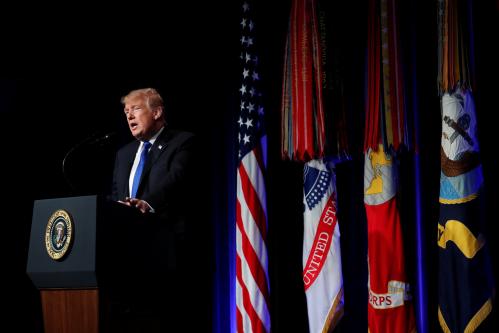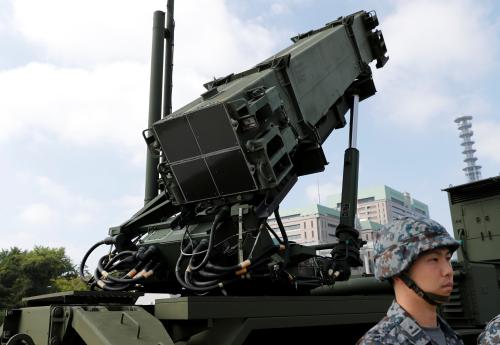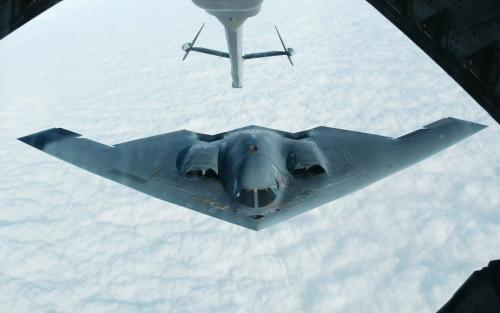In January, the Department of Defense released the 2019 Missile Defense Review (MDR), which describes the policies the United States will pursue to counter missile threats by rogue states and revisionist powers. On January 29, the Foreign Policy Program at Brookings hosted an event to discuss the MDR and its implications for U.S. defense policy. Assistant Secretary of Defense for Strategy, Plans, and Capabilities James Anderson kicked off the event with an address followed by a panel discussion.
Assistant Secretary Anderson
Assistant Secretary Anderson laid out the policy context of the review and the path it puts the United States on:
Since the previous Ballistic Missile Defense Review was released in 2010, potential adversaries have been rapidly developing and fielding an expanding range of new and advanced offensive missiles capable of threatening the United States and our allies and partners. To reflect the expanding offensive missile threat which includes non-ballistic systems such as advanced cruise and hypersonic weapons, we are calling this the Missile Defense Review.
He then made five points:
1) First, he emphasized the evolving threat environment. Highlighting offensive behavior in both cyberspace and outer space by America’s adversaries, Assistant Secretary Anderson noted that “the People’s Republic of China and the Russian Federation are carrying out military modernization programs to increase the capabilities of their existing missile systems while adding new and sophisticated types of missiles to their arsenals including hypersonic weapons and advanced cruise missiles.” Secretary Anderson added that North Korea and Iran are looming challenges to the current security environment.
2) Second, he laid out missile defense roles, policy, and strategy. In particular, the MDR “calls for a comprehensive approach to prevent and defeat adversary missile attacks through a combination of deterrents, active and passive missile defense and offensive operations.” Assistant Secretary Anderson stressed that key roles for missile defense include protecting the United States, forces abroad, and allies.
3) Third, he clarified the U.S. missile defense posture and its capabilities. By developing a new kill vehicle for the Ground-based Interceptor (GBI) and deploying 20 additional GBIs in Alaska (bringing the total of fielded interceptors to 64), America’s ground-based mid-course defense system will be strengthened in the face of a rogue intercontinental ballistic missile (ICBM) attack.
4) Next, he highlighted growing regional missile defense threat to U.S. forces abroad and America’s allies. Specifically, Assistant Secretary Anderson stressed that the Department of Defense is focusing on strengthening regional defense postures with the deployment of additional Patriot, Terminal High Altitude Area Defense (THAAD), and Aegis Ballistic Missile Defense systems, building mobile missile defense capabilities, and integrating America’s missile defenses with those of its allies.
5) Lastly, he detailed U.S. missile defense program management and future testing, noting that the Department of Defense will improve existing systems and explore the development of several new types of technologies, including compact high-energy lasers and spaced-based interceptors.
Expert Panel
Following Secretary Anderson’s remarks, Brookings Senior Fellow Michael O’Hanlon led a panel discussion with Richard Fieldhouse (formerly a professional staff member for the Senate Armed Services Committee), Rebeccah Heinrichs (a senior fellow at the Hudson Institute), and Brookings Senior Fellow Frank A. Rose.
O’Hanlon asked the panelists what struck them the most about the MDR. Fieldhouse observed the MDR expands the security aperture to include “not just ballistic missile defense, but also defense against cruise missiles, including advanced cruise missiles and hypersonic glide vehicles and hypersonic weapons.” Next, Heinrichs highlighted the continuity between the Obama administration’s 2010 Ballistic Missile Review and the Trump administration’s. Beyond their similarities, the differences include “Russia and China being discussed as threats in the context of regional missile defense,” and an “emphasis on space for missile defense.” Rose noted that there is also an examination of boost phase intercept and spaced-based capabilities to address more advanced threats. Furthermore, Rose highlighted that the development of spaced-based sensor capabilities could dramatically improve U.S. terrestrial based missile defense. However, the United States had already pursued spaced-based and boost-phase systems programs before they were canceled due to technical, operational, and cost issues.
Looking ahead, O’Hanlon turned the conversation to U.S. competitors. Fieldhouse emphasized that the MDR’s focus is on defending the homeland against rogue nations like North Korea and Iran, and not on defending the United States against the long-range capabilities of Russia or China. Heinrichs predicted that the line between rogue states and peer competitors will continually be blurred as technologies improve and rogue state threats continue to advance. Echoing the comments of his fellow panelists, Rose predicted two challenges for the defense community: addressing threats to the cyber security of America’s missile defense system, and developing ways to tackle more advanced threats. O’Hanlon noted that with studies conducted on a range of technologies over the years, space-based laser technology remains “extraordinarily difficult,” analogizing it to “essentially putting up a Hubble telescope and a huge laser for every single weapon you need to have,” all while keeping them at a fairly low altitude that results in a needing a large number of them in space. O’Hanlon concluded that there remain significant constraints on what we can realistically expect from technology, and that while theater defense or specific small countries like North Korea may allow options, the prospect of regional conflict against countries like China or Russia makes it “fairly hard to think that defensive technologies are really going to become predominant in the next ten years.”
Transitioning to the limitations of new technologies, such as directed energy and spaced-based interceptors, some of the panelists expressed skepticism. Fieldhouse repeated a joke he often heard on the Hill that “high energy lasers are the weapons of the future, and always will be.” Fieldhouse relayed that significant exploration and research on these new technologies is needed, and that the United States cannot depend on any of these technologies today or in the near-future. Heinrichs noticed increased optimism among engineers on the directed energy concept for boost phase application. However, she stressed that significant investment is needed to develop an initial spaced-based interceptor program. Observing that there has “been improvement,” Rose warned that there are still operational difficulties with boost phase defense and directed energy. In discussing the cancelled Airborne Laser program, Rose noted that the operational concept behind them is “very, very difficult” as they require a significant number of aircraft in order to be operationally effective. This sentiment was echoed by other panelists, with Fieldhouse explaining the program was cancelled in part because operating it would have required putting U.S. aircraft in close range to adversaries. Discussing the future feasibility of new technologies, Heinrichs cautioned that “it’s going to come down to what’s in the budget, [but] as I’ve been told many times by administration officials, [funds] may not just be [what’s allocated] in the missile defense budget.”
On the question of budgets, Rose expressed that the main budgetary challenge is determining how “we maintain our current capabilities and at the same time incrementally improve them to deal with evolving threats.” He noted that the Pentagon will be unable to afford everything. Heinrichs called for an increased amount of funding, but acknowledged that the final figure is dependent on President Trump’s forthcoming budget request. Fieldhouse repudiated the premise of a specific budgetary figure, arguing that budget caps and the new majority in the House will have the most influence on the budget.
In their discussion on the strategic implications of space-based missile interceptors, the panelists expressed varying views. Heinrichs commended the MDR for calling on the Pentagon to study the costs of space-based interceptors. She acknowledged that identifying kinetic options for them will require “a very significant commitment on the part of this administration to make that policy decision to invest in that to see if we can get an initial program started.” Heinrichs dismissed legal concerns, stressing that “nothing in the Outer Space Treaty prohibits the United States from putting space-based interceptors in outer space—nothing.” While Rose agreed with Heinrichs that the Outer Space Treaty doesn’t per se ban interceptors in space, he wondered if they’re stabilizing. Contrasting his time in the Obama administration when he frequently engaged in discussions with the Chinese and Russians on such issues, Rose called on the Trump administration “to take a more active role in space diplomacy.”
Timothy Holman, an intern with the Brookings Foreign Policy program, contributed to this post.
The Brookings Institution is committed to quality, independence, and impact.
We are supported by a diverse array of funders. In line with our values and policies, each Brookings publication represents the sole views of its author(s).








Commentary
Highlights from a recent discussion on the Missile Defense Review
February 6, 2019